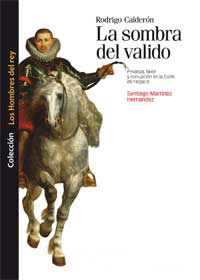Author
Santiago Martínez Hernández
Characteristics
400 pages; 22 black and white illustrations; flapped paperback; 14.5 x 22 cm
Publication
Spanish; preface by P. Williams; jointly published with Marcial Pons; 2009
ISBN
978-84-928200-3-0
Price
€26,92
Buy on our site and save 5% on this book until April 30
(coupon code: DÍA DEL LIBRO)
One of the lingering images associated with the last days of the Duke of Lerma’s power as royal minister was that of the favourite Don Rodrigo Calderón on his way to the scaffold. Although he was mythified after his death, there has been no study of him by historians–apart from some articles of undoubted significance–even though his personal and political life, plagued as it was with errors and excesses, offers the fascination of a singular and meteoric career. Don Rodrigo, who was Marquis of Siete Iglesias and Count of La Oliva, captain of the German Guard, secretary of the king’s chamber and ambassador extraordinary in the Netherlands, was one of Philip III’s most powerful and controversial ministers. He gained his well-known influence–the basis for an astonishing fortune, not always legitimately amassed–through being an indispensable support to the Duke of Lerma, and it enabled him to set himself up in very little time as the minister’s alter ego. He fell, like a Phaeton unseated from heaven in Quevedo’s lines, a victim to his patron’s loss of the king’s favour and to the pressures of an opposition born within the ruling clan. Subjected to a long trial in 1619, to torture and to privations, he was found guilty of numerous offences and sentenced to death. His public execution in Madrid’s Plaza Mayor on 21st October 1621 was, in the words of Andrés de Almansa y Mendoza, “the most famous day this century has seen”.
Santiago Martínez Hernández holds a doctorate in Modern History from the Universidad Complutense in Madrid, where he is currently a lecturer. His studies focus on court politics of the reigns of Philip II and Philip III, and he has published El marqués de Velada y la corte en los reinados de Felipe II y Felipe III (2004) and Governo, Politica e Representaçoes do Poder no Portugal Habsburgo e nos seus Territórios Ultramarinos (1581–1640) (2011), among other studies, as well as twenty or so articles and chapters in books.

